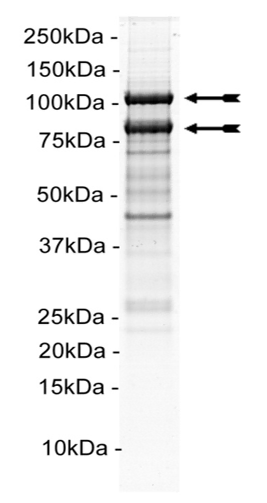PI3-Kinase (p110β/p85α) murine Mouse Recombinant Kinase Protein
Complex of N-terminal 6His-tagged, recombinant murine p110β, full length and untagged, recombinant, murine p85α, full length.
Biological information
Background
PI3 Kinase plays a key role by recruiting PH domain-containing proteins to the membrane, including AKT1 and PDPK1, activating signaling cascades involved in cell growth, survival, proliferation, motility and morphology. It also participates in cellular signaling in response to various growth factors and involved in the activation of AKT1 upon stimulation by receptor tyrosine kinases ligands such as EGF, insulin, IGF1, VEGFA and PDGF. PI3K regulates invadopodia formation through the PDPK1-AKT1 pathway, and participates in cardiomyogenesis in embryonic stem cells through a AKT1 pathway. In addition to its lipid kinase activity, it displays a serine-protein kinase activity that results in the autophosphorylation of the p85alpha regulatory subunit as well as phosphorylation of other proteins such as 4EBP1, H-Ras, the IL-3 beta c receptor and possibly others.
Target class
Kinase
Family
PI3K/PI4K
Accession number
NM_029094
Target Name
PI3-Kinase (p110β/p85α) murine Mouse Recombinant Kinase Protein
Target Alias
PIK3CA, PI3K, PK3CA
Origin
Mouse
Theori. MW
126 kDa (p110β), 84 kDa (p85α)
Affinity tag
6His
Product specifications
Expression system
Expressed by baculovirus in Sf21 insect cells
Purity
Refer to CoA for Purity
Purification method
Ni2+/NTA-agarose
Sample Buffer
Protein in 50mM Tris/HCl pH7.5, 300mM NaCl, 0.1mM EGTA, 0.03% Brij-35, 270mM sucrose, 0.2mM PMSF, 1mM benzamidine, 0.1% 2-mercaptoethanol. Frozen solution.
Specified activity
Refer to CoA
Application
For Research Only
Storage conditions
6 months at -70°C
Usage disclaimer
For Research Only
Chemical data
Background
PI3 Kinase plays a key role by recruiting PH domain-containing proteins to the membrane, including AKT1 and PDPK1, activating signaling cascades involved in cell growth, survival, proliferation, motility and morphology. It also participates in cellular signaling in response to various growth factors and involved in the activation of AKT1 upon stimulation by receptor tyrosine kinases ligands such as EGF, insulin, IGF1, VEGFA and PDGF. PI3K regulates invadopodia formation through the PDPK1-AKT1 pathway, and participates in cardiomyogenesis in embryonic stem cells through a AKT1 pathway. In addition to its lipid kinase activity, it displays a serine-protein kinase activity that results in the autophosphorylation of the p85alpha regulatory subunit as well as phosphorylation of other proteins such as 4EBP1, H-Ras, the IL-3 beta c receptor and possibly others.
Compound name
Kinase
Catalog number
14-794
Molecular formula
CAS
MW
Ka
Percent composition
Product specifications
Physical state
Purity (HPLC 214nm)
Retention time (RP18 HPLC)
CMC
Exact mass
Stability
For Research Only
Solubility structure
Kinase Activity Assay Biological information
Background
PI3 Kinase plays a key role by recruiting PH domain-containing proteins to the membrane, including AKT1 and PDPK1, activating signaling cascades involved in cell growth, survival, proliferation, motility and morphology. It also participates in cellular signaling in response to various growth factors and involved in the activation of AKT1 upon stimulation by receptor tyrosine kinases ligands such as EGF, insulin, IGF1, VEGFA and PDGF. PI3K regulates invadopodia formation through the PDPK1-AKT1 pathway, and participates in cardiomyogenesis in embryonic stem cells through a AKT1 pathway. In addition to its lipid kinase activity, it displays a serine-protein kinase activity that results in the autophosphorylation of the p85alpha regulatory subunit as well as phosphorylation of other proteins such as 4EBP1, H-Ras, the IL-3 beta c receptor and possibly others.
Target class
Kinase
Family
PI3K/PI4K
Subfamily
Protein Name
PI3Kβ/p85α
Protein Alias
PIK3CA, PI3K, PK3CA
Accession Number
NM_029094
UniProt Number
Gene Name
Gene ID
Gene Aliases
Target Species
Mouse
Kinase Activity Assay Usage
Product Type
Application
Storage Conditions
6 months at -70°C
Usage disclaimer
Kinase Activity Assay Information
Assay Type
Assay Measures
Biological Information
Background
PI3 Kinase plays a key role by recruiting PH domain-containing proteins to the membrane, including AKT1 and PDPK1, activating signaling cascades involved in cell growth, survival, proliferation, motility and morphology. It also participates in cellular signaling in response to various growth factors and involved in the activation of AKT1 upon stimulation by receptor tyrosine kinases ligands such as EGF, insulin, IGF1, VEGFA and PDGF. PI3K regulates invadopodia formation through the PDPK1-AKT1 pathway, and participates in cardiomyogenesis in embryonic stem cells through a AKT1 pathway. In addition to its lipid kinase activity, it displays a serine-protein kinase activity that results in the autophosphorylation of the p85alpha regulatory subunit as well as phosphorylation of other proteins such as 4EBP1, H-Ras, the IL-3 beta c receptor and possibly others.
Target class
Kinase
Family
PI3K/PI4K
Accession Number
NM_029094
Target Name
PI3Kβ/p85α
Target Alias
PIK3CA, PI3K, PK3CA
Origin
Mouse
Theoretical MW
Affinity Tag
6His
Product Specifications
Expression system
Expressed by baculovirus in Sf21 insect cells
Purity
Refer to CoA for Purity
Purification method
Ni2+/NTA-agarose
Sample Buffer
Specified activity
Refer to CoA
Application
Storage conditions
6 months at -70°C
Usage disclaimer
For Research Only
Biological Information
Background
PI3 Kinase plays a key role by recruiting PH domain-containing proteins to the membrane, including AKT1 and PDPK1, activating signaling cascades involved in cell growth, survival, proliferation, motility and morphology. It also participates in cellular signaling in response to various growth factors and involved in the activation of AKT1 upon stimulation by receptor tyrosine kinases ligands such as EGF, insulin, IGF1, VEGFA and PDGF. PI3K regulates invadopodia formation through the PDPK1-AKT1 pathway, and participates in cardiomyogenesis in embryonic stem cells through a AKT1 pathway. In addition to its lipid kinase activity, it displays a serine-protein kinase activity that results in the autophosphorylation of the p85alpha regulatory subunit as well as phosphorylation of other proteins such as 4EBP1, H-Ras, the IL-3 beta c receptor and possibly others.
Target class
Kinase
Family
PI3K/PI4K
Accession Number
NM_029094
Target Name
PI3Kβ/p85α
Target Alias
PIK3CA, PI3K, PK3CA
Origin
Mouse
Theoretical MW
Affinity Tag
6His
Product Specifications
Expression system
Expressed by baculovirus in Sf21 insect cells
Purity
Refer to CoA for Purity
Purification method
Ni2+/NTA-agarose
Sample Buffer
Specified activity
Refer to CoA
Application
Storage conditions
6 months at -70°C
Usage disclaimer
For Research Only




